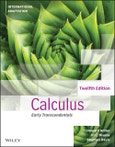Calculus: Early Transcendentals, 12th Edition delivers a rigorous and intuitive exploration of calculus, introducing polynomials, rational functions, exponentials, logarithms, and trigonometric functions early in the text. Using the Rule of Four, the authors present mathematical concepts from verbal, algebraic, visual, and numerical points of view. The book includes numerous exercises, applications, and examples that help readers learn and retain the concepts discussed within. This new adapted twelfth edition maintains those aspects of the previous editions that have led to the series success, at the same provides freshness to the new edition that would attract new users.
Table of Contents
CHAPTER 1 Limits and Continuity1.1 Limits (An Intuitive Approach)
1.2 Computing Limits
1.3 Limits at Infinity; End Behavior of a Function
1.4 Limits (Discussed More Rigorously)
1.5 Continuity
1.6 Trigonometric Functions
1.7 Inverse Trigonometric Functions
1.8 Exponential and Logarithmic Functions
CHAPTER 2 The Derivative
2.1 Tangent Lines and Rates of Change
2.2 The Derivative Function
2.3 Introduction to Techniques of Differentiation
2.4 The Product and Quotient Rules
2.5 Derivatives of Trigonometric Functions
2.6 The Chain Rule
CHAPTER 3 Differentiation
3.1 Implicit Differentiation
3.2 Derivatives of Logarithmic Functions
3.3 Derivatives of Exponential and Inverse Trigonometric Functions
3.4 Related Rates
3.5 Local Linear Approximation; Differentials
3.6 L'Hôpital's Rule; Indeterminate Forms
CHAPTER 4 The Derivative in Graphing and Applications
4.1 Analysis of Functions I: Increase, Decrease, and Concavity
4.2 Analysis of Functions II: Relative Extrema; Graphing Polynomials
4.3 Analysis of Functions III: Rational Functions, Cusps, and Vertical Tangents
4.4 Absolute Maxima and Minima
4.5 Applied Maximum and Minimum Problems
4.6 Rectilinear Motion
4.7 Newton's Method
4.8 Rolle's Theorem; Mean-Value Theorem
CHAPTER 5 Integration
5.1 An Overview of Area and Speed-Distance Problems
5.2 The Indefinite Integral
5.3 Integration by Substitution
5.4 The Definition of Area as a Limit; Sigma Notation
5.5 The Definite Integral
5.6 The Fundamental Theorem of Calculus
5.7 Rectilinear Motion Revisited Using Integration
5.8 Average Value of a Function and its Applications
5.9 Evaluating Definite Integrals by Substitution
5.10 Logarithmic and Other Functions Defined by Integrals
CHAPTER 6 Applications of the Definite Integral
6.1 Area Between Two Curves
6.2 Volumes by Slicing; Disks and Washers
6.3 Volumes by Cylindrical Shells
6.4 Length of a Plane Curve
6.5 Area of a Surface of Revolution
6.6 Work
6.7 Moments, Centers of Gravity, and Centroids
6.8 Fluid Pressure and Force
6.9 Hyperbolic Functions and Hanging Cables
CHAPTER 7 Principles of Integral Evaluation
7.1 An Overview of Integration Methods
7.2 Integration by Parts
7.3 Integrating Trigonometric Functions
7.4 Trigonometric Substitutions
7.5 Integrating Rational Functions by Partial Fractions
7.6Using Computer Algebra Systems and Tables of Integrals
7.7 Numerical Integration; Simpson's Rule
7.8 Improper Integrals
CHAPTER 8 Mathematical Modeling with Differential Equations
8.1 Modeling with Differential Equations
8.2 Separation of Variables
8.3 Slope Fields; Euler's Method
8.4 First-Order Differential Equations and Applications
8.5 Prey-Predator Model
CHAPTER 9 Parametric and Polar Curves; Conic Sections
9.1 Parametric Equations; Tangent Lines and Arc Length for Parametric Curves
9.2 Polar Coordinates
9.3 Tangent Lines, Arc Length, and Area for Polar Curves
9.4 Conic Sections
9.5 Rotation of Axes; Second-Degree Equations
9.6 Conic Sections in Polar Coordinates
CHAPTER 10 Sequence and Infinite Series
10.1 Sequences
10.2 Monotone Sequences
10.3 Infinite Series
10.4 Convergence Tests
10.5 The Comparison, Ratio, and Root Tests
10.6 Alternating Series; Absolute and Conditional Convergence
10.7 Maclaurin and Taylor Polynomials
10.8 Maclaurin and Taylor Series; Power Series
10.9 Convergence of Taylor Series
10.10 Differentiating and Integrating Power Series; Modeling with Taylor Series
CHAPTER 11 Three-dimensional Space; Vectors
11.1 Rectangular Coordinates in 3-space; Spheres; Cylindrical Surfaces
11.2 Vectors
11.3 Dot Product; Projections
11.4 Cross Product
11.5 Parametric Equations of Lines
11.6 Planes in 3-space
11.7 Quadric Surfaces
11.8 Cylindrical and Spherical Coordinates
CHAPTER 12 Vector-Valued Functions
12.1 Introduction to Vector-Valued Functions
12.2 Calculus of Vector-Valued Functions
12.3 Change of Parameter; Arc Length
12.4 Unit Tangent, Normal, and Binormal Vectors
12.5 Curvature
12.6 Motion Along a Curve
12.7 Kepler's Laws of Planetary Motion
CHAPTER 13 Partial Derivatives 13.1 Functions of Two or More Variables
13.2 Limits and Continuity
13.3 Partial Derivatives
13.4 Differentiability, Differentials, and Local Linearity
13.5 The Chain Rule
13.6 Directional Derivatives and Gradients
13.7 Tangent Planes and Normal Vectors
13.8 Maxima and Minima of Functions of Two Variables
13.9 Lagrange Multipliers
CHAPTER 14 Multiple Integrals
14.1 Double Integrals
14.2 Double Integrals Over Nonrectangular Regions
14.3 Double Integrals in Polar Coordinates
14.4 Surface Area; Parametric Surfaces
14.5 Triple Integrals
14.6 Triple Integrals in Cylindrical and Spherical Coordinates
14.7 Change of Variables in Multiple Integrals; Jacobians
14.8Centers of Gravity Using Multiple Integrals
CHAPTER 15 Vector Calculus
15.1 Vector Fields
15.2 Line Integrals
15.3 Independence of Path; Conservative Vector Fields
15.4 Green's Theorem
15.5 Surface Integrals
15.6 Applications of Surface Integrals; Flux
15.7 The Divergence Theorem
15.








